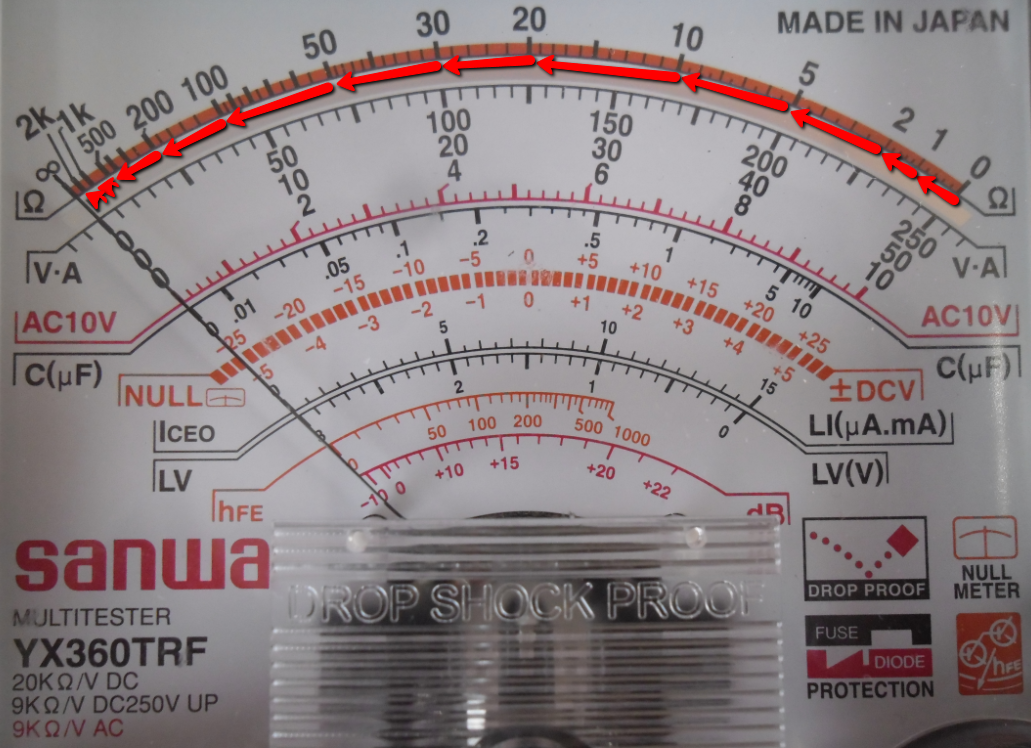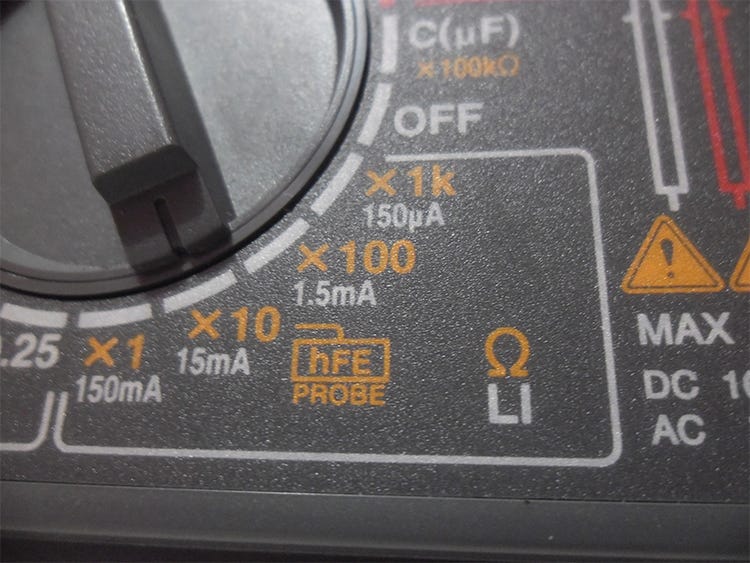How to Read an Ohm Meter Scale
Measuring resistance on electronic components whether doing information technology individually or in-circuit, is not simple unless you lot had learned how to read resistance calibration using an ohmmeter of an analog multi-tester. It'south non as hard every bit you recall perchance by looking the overwhelming numbers and values. Once you lot understand it, yous will realize how unproblematic it is.
As you lot can see in the image below, resistance scale is located in the summit most office of a meter console. You may take noticed a descending guild of number. From left (∞) to correct (0). In practice, reading values always starts from zero. Therefore we will read resistance values from right to left which is zero (0) to infinity (∞) .
Notation: Reading resistance values is an verbal contrary of reading "voltage" and "current" since ACV (Ac voltmeter) and DCV (Dc voltmeter) scale is in ascending guild. You may have noticed how their values starts from left (0, 0, 0) to right (ten, fifty, 250).
Since nosotros will read resistance values from right to left, encounter to it that the gaps between numbers are non equally divided. Delight don't get and so confused why it is not equal. In fact, it'due south not a big deal. After all what we need to learn is the value of each calibration betwixt each numbers. Those small-scale vertical lines that divide on each number is a scale. Each scale has a value with respect to each nearest number.

- To fully sympathise it, we volition make a list of numbers from nothing (0) to infinity (∞) with its individual scale and value.
- See the ruby lines below the resistance calibration and compare it to the list beneath.
0–one — is divided by v scales. Each scale has a value of 0.two ohm. Therefore 0.ii ohm multiplied by 5 scales is equal to one ohm.
1–2 — as well divided by 5 scales. Each scale has a value of 0.ii ohm. Therefore 0.2 ohm multiplied by 5 scales is equal to 1 ohm. Adding all the value from zip, nosotros become a total of two ohms.
two–five — is divided past six scales. Each calibration has a value of 0.5 ohm. Therefore 0.5 ohm multiplied by 6 scales is equal to 3 ohms. Calculation all the value from zero, we get a total of 5 ohms.
5–ten — is divided by 10 scales. Each scale has a value of 0.5 ohm. Therefore 0.5 ohm multiplied by 10 scales is equal to five ohms. Calculation all the value from zero, we get a total of 10 ohms.
10–20 — is divided by 10 scales. Each scale has a value of 1 ohm. Therefore ane ohm multiplied by 10 scales is equal to 10 ohms. Adding all the value from zero, we become a full of 20 ohms.
xx–30 — is divided past five scales. Each scale has a value of 2 ohms. Therefore 2 ohms multiplied by five scales is equal to ten ohms.
Adding all the value from nada, we become a total of 30 ohms.
thirty–50 — is divided by 10 scales. Each scale has a value of 2 ohms. Therefore 2 ohms multiplied by ten scales is equal to 20 ohms. Adding all the value from zero, nosotros get a full of l ohms.
50–100 — is divided by 10 scales. Each scale has a value of v ohms. Therefore five ohms multiplied by 10 scales is equal to fifty ohms. Adding all the value from zero, we get a total of 100 ohms.
100–200 — is divided by 5 scales. Each scale has a value of twenty ohms. Therefore 20 ohms multiplied past five scales is equal to 100 ohms. Adding all the value from goose egg, we get a full of 200 ohms.
200–500 — is divided past 4 scales. Each calibration has a value of 75 ohms. Therefore 75 ohms multiplied past 4 scales is equal to 300 ohms. Adding all the value from zero, we get a total of 500 ohms.
500–1k — is not divided by a calibration. Therefore from 500, you will go the value of ane kilo-ohms (1K) by adding 500 ohms. And so, it is very obvious that the gap between 500 ohms and 1k is 500 ohms. Adding all the value from nil, we become a total of 1 kilo-ohms (1K).
1k-2k — is non divided by a scale. Therefore from 1K, you volition go the value of 2k past adding 1K. So, the gap is patently ane kilo-ohms (1K). Calculation all the value from zero, nosotros get a total of 2 kilo-ohms (2K).
Notation: Chiliad stands for Kilo which means Chiliad.
Any value that goes across 2K or 2 kilo-ohms value has a very high resistance and exceed the x1 multiplier range of an ohmmeter.
Please note that the highest resistance calibration is but limited to 2k or two kilo-ohm resistance. If y'all need to measure resistance which is higher than 2 kilo-ohms, set the ohmmeter range to a higher multiplier range then on.
Learning to read resistance values is easy. Just by knowing the value of each scale individually could fulfill it. Only there'south more to acquire if you dig deeper.
Here are the questions that arises on your thoughts:
What is a multiplier?
These are the 4 range of an ohmmeter, as you can encounter in the image below. An ohmmeter is divided past four main settings.
a) x1 — select this range so that whatever value in the resistance calibration is multiplied by i.
b) x10 — select this range so that any value in the resistance scale is multiplied by 10.
c) x100 — select this range and so that whatever value in the resistance scale is multiplied by 100.
d) x1k — select this range and so that any value in the resistance scale is multiplied by 1k or i thousand.
Does each range is has its own sensitivity?
- x1 — has the everyman sensitivity
- x1k — has the highest sensitivity
What range should be used in resistance measurement?
- x1 — Select this range if you are measuring resistance beneath ii kilo-ohms.
- x10 — Select this range if you are measuring resistance below 20 kilo-ohms.
- x100 — Select this range if you are measuring resistance below 200 kilo-ohms.
- x1k — Select this range if yous are measuring resistance below 2 mega-ohms.

Learning resistance measurement is simple but yous need to practice. Familiarize the value of each scale and memorize it. Put it in practise, measure out the resistance of an actual electronic components such as resistors, transistors and diodes. Information technology's not very long you lot realize y'all'd already done it with ease.
If i missed something or messes something up, please put it in the comments below and i'll gladly make an update correct away.
grazianohavol1937.blogspot.com
Source: https://medium.com/@phillipfixit/how-to-read-resistance-scale-in-analog-multi-tester-fa655ccf4ba4
0 Response to "How to Read an Ohm Meter Scale"
Post a Comment